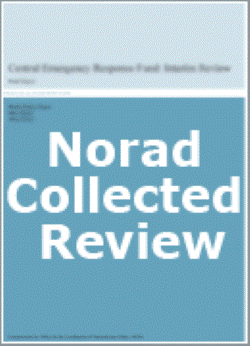Evaluation of the Centre for Peace Initiatives in
Om publikasjonen
- Utgitt: januar 2010
- Serie: Norad-innsamlede rapporter
- Type: --
- Utført av: SIPU International AB, Lars Oscàr, Peter Weiderud, Godfrey Manungo, Númi Östlund
- Bestilt av: Royal Norwegian Embassy in Harare, Sida, EC
- Land: Zimbabwe
- Tema: Konflikt, fred og sikkerhet
- Antall sider: 84
- Serienummer: 23/2009
- ISBN: 978-82-7548-468-8
- ISSN: --
- Prosjektnummer: zib 09 /021

The Project
The Centre for Peace Initiatives in Africa (CPIA) was founded in Zimbabwe in 2001. The organisation mainly works with dialogue activities in Zimbabwe to achieve its overall objective of contributing towards the promotion of sustainable peace, stability and security in Africa through conflict prevention and management.
CPIA has been supported by a range of donors over the years, namely the Swedish International Development Cooperation Agency (Sida), together with the Royal Norwegian Embassy (RNE) and the Canadian International Development Agency (CIDA), the European Commission (EC), and the Netherlands. Finland has just entered into an agreement for support to CPIA during 2009.
The organisation has received about NOK 13 mill from the donor countries. Norway has supported the programme with about NOK 3 mill.
Interesting Findings
• The National Dialogue on Zimbabwe programme has been the most important, and most successful, programme. Stakeholders from all walks of life have been brought to the same table to discuss those topics considered relevant by the stakeholders. It is clear to the Team that the CPIA has been the only actor in Zimbabwe able to convene this type of meetings. Meetings have included activities of a more social nature too, such as braais, lunches and dinners. From the persons interviewed by the Team, it is difficult to substantiate or point to concrete outcomes of the programme, but the overall result of the interviews verify that the programme contributed to decreased political tensions in the country.
• The failure to point to concrete outcomes does not mean that the programme has been less valued by stakeholders or should be less appreciated by donors. Outcomes from a political process are not necessarily concrete, and growing trust might be verified, but not possible to quantify. The CPIA should have been paying more attention to the need to follow up on this process and reporting on it to donors as well as all stakeholders in Zimbabwe.
• The agreement on a Unity Government, included in the Constitution as amendment no 19, refers extensively to the need for national healing and reconciliation, which has resulted in the appointment of three ministers of state for national healing, one from each political party, and a National Healing Organ has been created. It was not confirmed by the persons interviewed by the Team to what extent this has been a result of the CPIA lobbying Parliament is not possible to say, but it seems likely that it have had an influence on the process.
• The activities under the Regional programme were CPIA attendance at a few meetings. A SADC regional consultative meeting on ECOSOC was attended by CPIA staff in 2006, and meetings on strengthening the peace potential in Southern Africa and aid effectiveness attended in 2007, and similarly a SADC civil society forum on regional integration in 2008. These activities can not be seen as a unified programme. Neither the purposes of CPIA participation in, nor the results of, these workshops are clear to the Team. Before any more regional activities are undertaken, the CPIA needs to strategise and plan how the organisation can make a difference in another country and/or on a regional scale.
• A significant shortcoming of the CPIA is its failure to set measurable success indicators at the outset of programmes, and follow up on these during implementation. The donors should not accept to fund a programme where indicators are not elaborated in the programme document. The progress should be documented in reports, which are disseminated to stakeholders and donors. In addition, the CPIA itself should make use of experiences collected in reports to further its own development.
